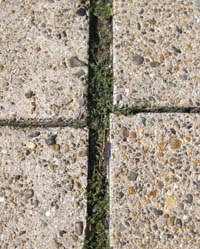This weekend marks what was once the proper start of the year’s racing season, in years past any event before Het Volk was effectively a training race. Now known as Het Nieuwsblad (“the newspaper”), Saturday sees the Belgian season start and it’s followed by Kuurne-Brussels-Kuurne on Sunday.
Many races in Flanders feature cobbles, from residential roads lined with ornamental pavé to full on agricultural tracks still surfaced with medieval stones. There are flat sections and in the infamous hellingen – the plural of “slope” or “ramp” in Dutch – with their steep gradients. These are strategic points in the race, crowds gather and it makes for great TV, riders pedalling squares as they bounce their way up, the difference between the leaders and those struggling to keep in contention is amplified ten times.
But there’s also something else that’s 100% Belgian: the concrete road, the betonweg. Safer and smoother than the cobbles, Belgium has many rural roads surfaced with concrete instead of tarmac. Large sections of concrete are separated by small gaps, partly for drainage but also to let the material expand on a hot day, to avoid the surface buckling under expansion.

Riders using these roads have to avoid the central channel, usually a tyre’s width, and endure the constant bump every few of seconds as they cross from one block to the next. Often the cracks have tufts of vegetation. These roads are smooth compared to cobbles but the bump in between each section does wear a rider down, the constant thump… thump… thump only adds to the fatigue after hours of experience especially as you tend to race full speed and don’t relax or brace for the bumps, that way the shock comes straight up the forks to the wrists.
These things don’t determine a race, no way. But they do drain a rider and whilst not unique to Belgium, the country has more than its fair share. Look out for the betonweg this weekend.
* on a point of fact, the images used here are of Danish roads but they could just as well be in Flanders. I couldn’t easily find a useful photo of roads from Belgium. If you have a good image, please get in touch.


Fantastic
The air in the UK is warming up, the smell of the Tour of Flanders is weeks away, let the season BEGIN!
The examples pictured above are of quite good quality. We have a maraton event in Slovenia that runs across a stretch of concrete road that is in horrific shape, with random patches of tarmac to even out the biggest holes..
Urgh, this brings back memories. Second day of a 4 month European tour. Off the ferry and into Belgium, to be confronted with what felt like endless miles of this stuff. It’s how I imagine water torture: mounting agitation at the anticipation of another regular jar to the senses. The sum is certainly worse than the parts.
Martin: crosswinds and rain showers are forecast for Flanders.
Gandalf: for sure, I’ve seen worse examples, it’s more that even off the cobbles the riders have more bumps, the concrete is often normal.
drfront: it’s bad driving on it and annoying for riding, it just saps a bit of momentum and sometimes the edges can be rough. As you say, very Belgian.
The only good thing with the betonwegen is when you finish the cobbles and get on the beton, it gives the feeling like you are floating.
Oh yes, they are very Belgian. I hate them and still ride on them quite frequently. It’s an absolute shame that often the most beautiful landscapes are spoiled by riding on those bastards. Although the cobbles are harder and more painful, the concrete is more monotonous and mind numbing and usually longer than the cobbles, making them the far less likable experience in my book.
I raced the amateur Kermis scene in Belgie on six different trips to the “Motherland”. You’d think the things I remember are crosswind battles, cobbles and rain jackets in and out of the pockets.
Nope, your story has brought up the ultimate in memories. Concrete roads and those crazy unfilled spaces! Holy poop, riding in a nervous 175 rider peloton, whilst crossing back and forth across those damn things, just hoping you weren’t the one who finally got your 23mm tire caught in the 30mm gap.
If there is one thing Belgium is good at, it’s creating racing experiences that you’ll never forget.
Ah yes, the beginning of the Spring Classics season. Or as I like to call it: the “Euskaltel Riders Falling Down and Frequently Hurting Themselves Quite Badly” season.
I googled on ‘Vlaamse betonweg’ and found this:
http://tandemtour.net/2008/pictures/betonweg.JPG
If you look closely, you can see the grass growing in the gap in the middle.
this kind of road (Ronde 2008)… http://threepockets.blogspot.com/2011/02/reservewielen.html
Here is a particularly good one for once
http://www.rsv-aachen.de/impressionen.html?verz=Fleche_Wallone_2008/Michael&bild=CIMG1363_620px.jpg#bild
http://www.rsv-aachen.de/impressionen.html?verz=Fleche_Wallone_2008/Roland&bild=DSC00069_620px.jpg#bild